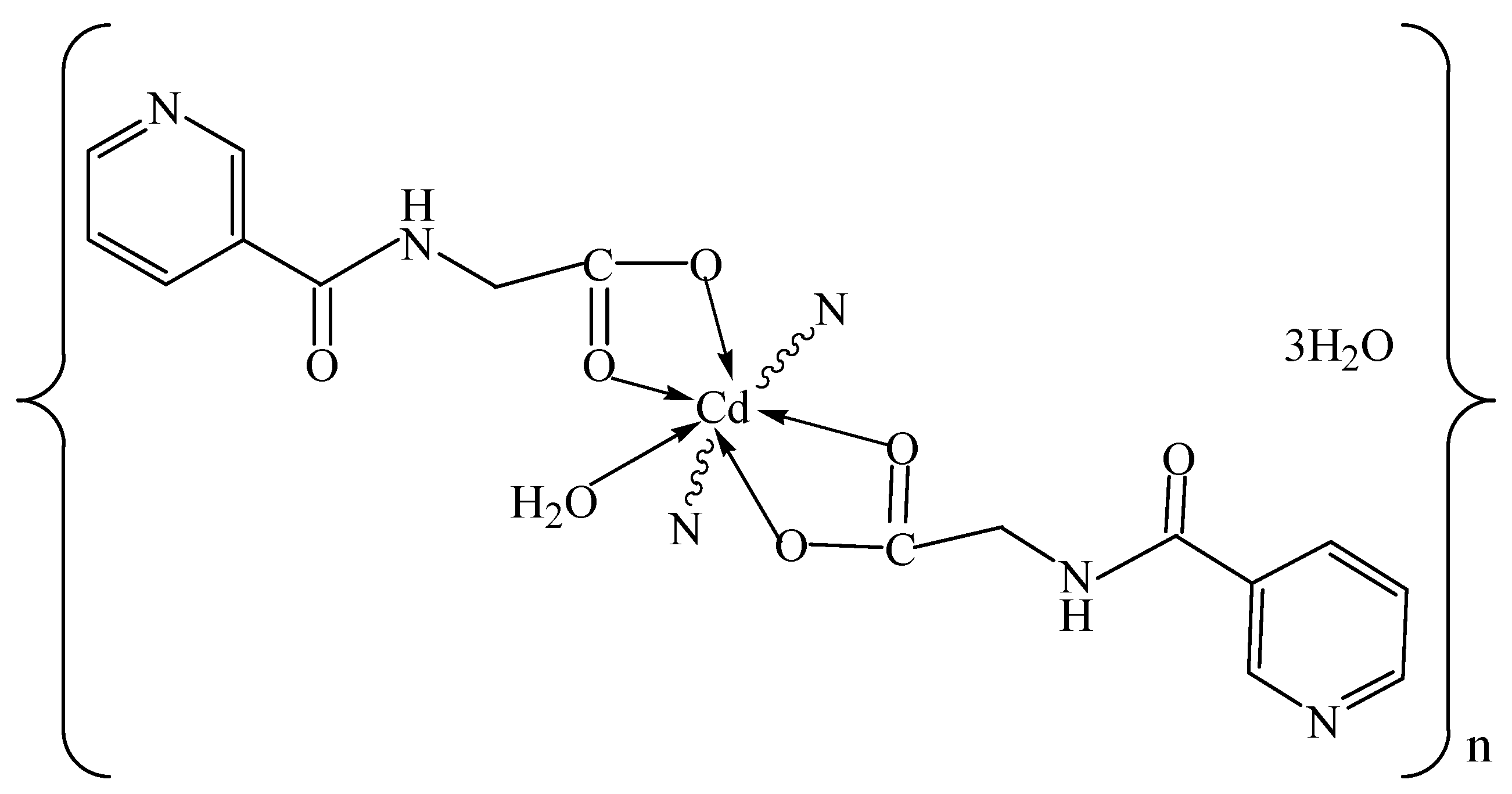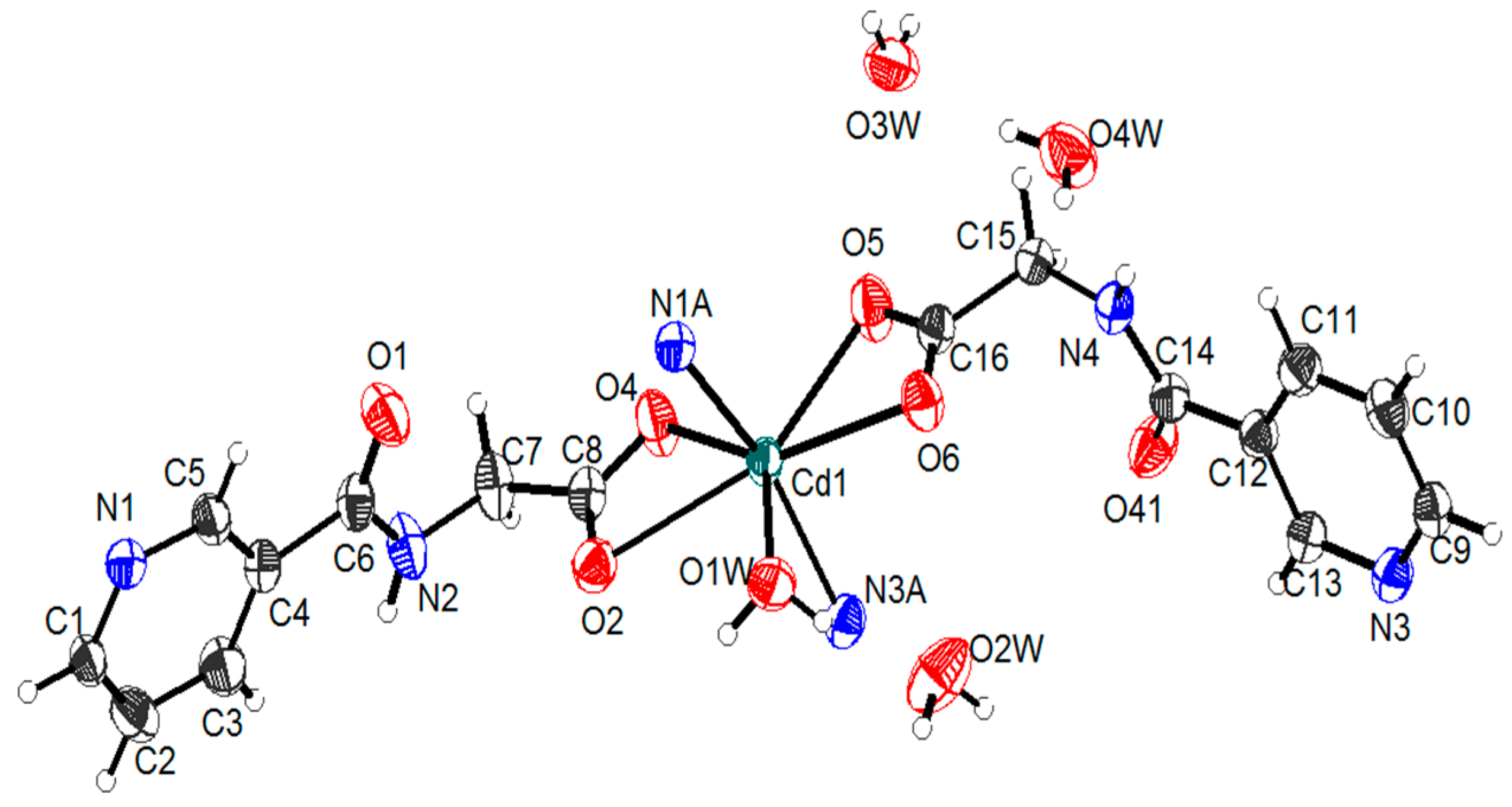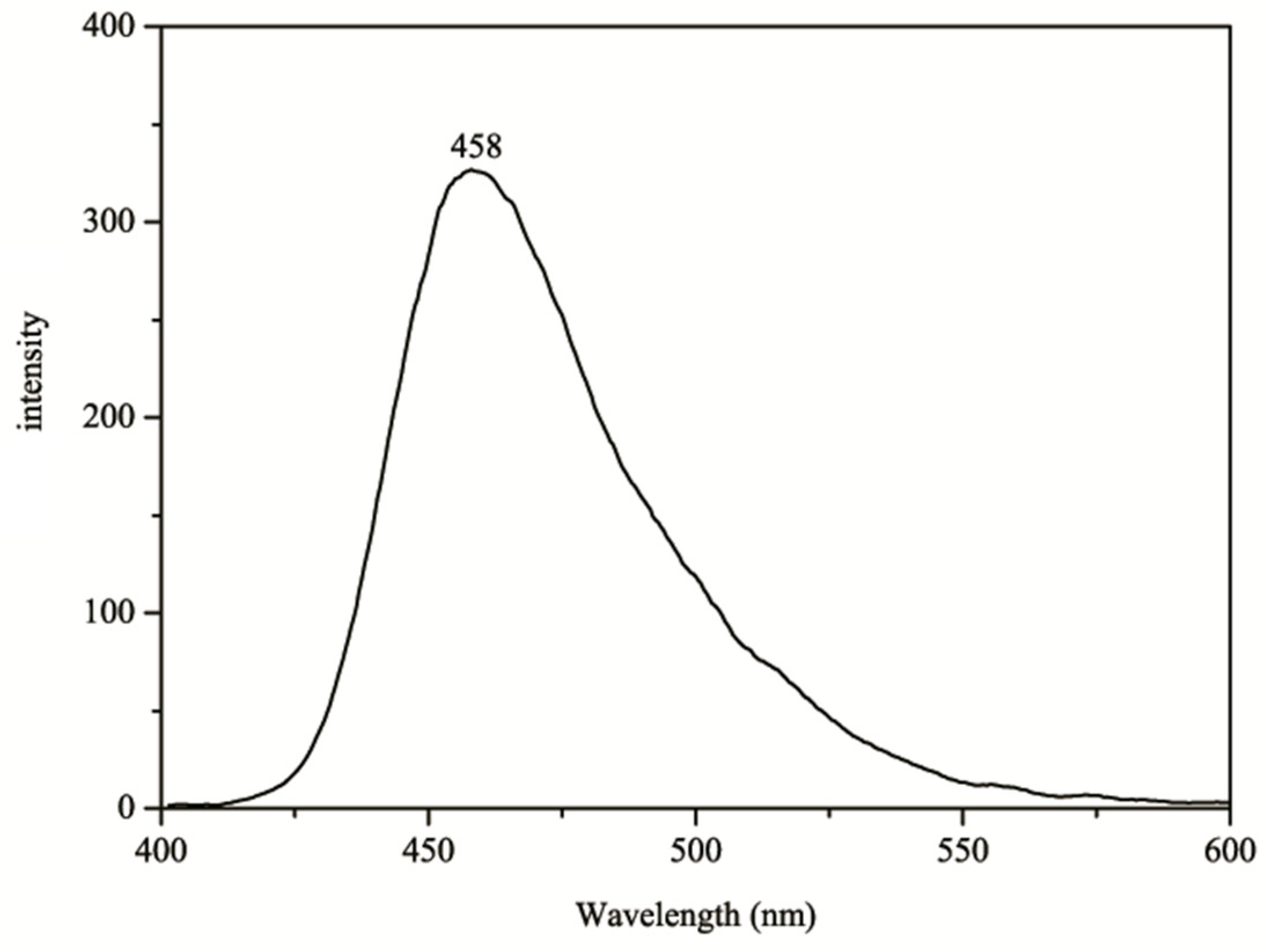Synthesis, Crystal Structure, and Luminescent Property of a Cd(II) Coordination Polymer with a N-Nicotinoylglycine Ligand
Abstract
:1. Introduction
2. Results and Discussion
2.1. Characterization of [{CdL2(H2O)}·(H2O)3]n
2.2. Structural Description of [{CdL2(H2O)}·(H2O)3]n
2.3. Luminescent Property
3. Experimental Section
3.1. Materials and Instrumentation
3.2. Synthesis of [{CdL2(H2O)}·(H2O)3]n
3.3. Crystal Structure Determination
4. Conclusions
Acknowledgments
Author Contributions
Conflicts of Interest
Appendix A
References
- Yu, X.Y.; Zhang, X.; Qu, X.S.; Ma, M.S.; Liu, Z.G.; Jin, L.; Yang, Y.Y.; Luo, Y.N. A new 3D Cd(II) coordination polymer with metallacalix[4]arene building blocks based on 2-(pyridine-2-yl)-1H-imidazole-4,5-dicarboxylic acid. J. Coord. Chem. 2015, 68, 3580–3588. [Google Scholar] [CrossRef]
- Hazari, D.; Jana, S.K.; Puschmann, H.; Zangrando, E.; Dalai, S. Three new Coordination polymers of zinc(II) and cadmium(II) with dicarboxylate and bipyridine ligands: Synthesis, structure and luminescence study. J. Inorg. Organomet. Polym. Mater. 2015, 25, 1151–1159. [Google Scholar] [CrossRef]
- Yang, L.R.; Liu, L.; Lian, C.; Liu, M.Y.; Xu, Z.H.; Wang, L.C.; Guo, X.; Long, Y.S. Zero-, one-, two-, and three-dimensional coordination polymers based on tetracarboxylic acid: Syntheses, structures, magnetic and luminescent properties. Dyes Pigments 2015, 122, 246–256. [Google Scholar] [CrossRef]
- Yoon, M.; Moon, D. New Zr(IV) based metal-organic framework comprising a sulfur-containing ligand: Enhancement of CO2 and H2 storage capacity. Microporous Mesoporous Mater. 2015, 215, 116–122. [Google Scholar] [CrossRef]
- Wang, X.L.; Luan, J.; Lin, H.Y.; Liu, G.C.; Le, M. Four cobalt(II) coordination polymers based on a flexible N,N′-bis(3-pyridinecarboxamide)-1,6-hexane ligand: Modulation of crystal architectures through the substituent groups of isophthalates. Polyhedron 2014, 71, 111–118. [Google Scholar] [CrossRef]
- Saravanakumar, R.; Varghese, B.; Sankararaman, S. Isostructural 1D coordination polymers of Zn(II), Cd(II) and Cu(II) with phenylpropynoic acid and DABCO as organic linkers. J. Mol. Struct. 2014, 1076, 280–284. [Google Scholar] [CrossRef]
- Bajpai, A.; Chandrasekhar, P.; Govardhan, S.; Banerjee, R.; Moorthy, J.N. Single crystal-to-single crystal site-selective postsynthetic metal exchange in a Zn-MOF based on semi-rigid tricarboxylic acid and access to bimetallic MOFs. Chem. Eur. J. 2015, 21, 2759–2765. [Google Scholar] [CrossRef] [PubMed]
- Yang, Y.X.; Li, H.Y.; Wu, J.F. Synthesis and crystal structures of inclusion compounds of 2,2′-dithiosalicylic acid and triethylamine/tripropylamine. Crystallogr. Rep. 2015, 60, 1006–1012. [Google Scholar] [CrossRef]
- Guo, X.H.; Zhang, X.; Zhao, L.Y.; Zhang, N.X.; Yi, Z.H. Synthesis and crystal structure of cadmium coordination polymer with 1,3,5-benzenetricarboxylic acid. Crystallogr. Rep. 2015, 60, 860–864. [Google Scholar] [CrossRef]
- Zhang, J.W.; Kan, X.M.; Li, X.L.; Liu, Y.; Liu, B.Q. A series of copper-lanthanide heterometallic coordination polymers derived from pyridine-2,3-dicarboxylic acid and in situ generated succinic acid. Eur. J. Inorg. Chem. 2016, 2016, 1060–1067. [Google Scholar] [CrossRef]
- Guo, X.M.; Yan, Y.N.; Guo, H.D.; Wang, N.; Qi, Y.J. Construction of two novel coordination polymers from a V-shaped bisimidazole ligand: Synthesis, characterization and properties. Inorg. Chem. Commun. 2016, 64, 59–62. [Google Scholar] [CrossRef]
- Li, T.; Huang, X.H.; Zhao, Y.F.; Li, H.H.; Wu, S.T.; Huang, C.C. An unusual double T5(2) water tape trapped in silver(I) coordination polymer hosts: Influence of the solvent on the assembly of Ag(I)-4,4′-bipyridine chains with trans-cyclohexanedicarboxylate and their luminescent properties. Dalton Trans. 2012, 41, 12872–12881. [Google Scholar] [CrossRef] [PubMed]
- Liu, C.B.; Li, Q.; Wang, X.; Che, G.B.; Zhang, X.J. A series of lanthanide(III) coordination polymers derived via in situ hydrothermal decarboxylation of quinoline-2,3-dicarboxylic acid. Inorg. Chem. Commun. 2014, 39, 56–60. [Google Scholar] [CrossRef]
- Tai, X.S.; Zhao, W.H. Synthesis, crystal structure and antitumor activity of Ca(II) coordination polymer based on 1,5-naphthalenedisulfonate. J. Inorg. Organomet. Polym. Mater. 2013, 23, 1354–1357. [Google Scholar] [CrossRef]
- Tai, X.S.; Wang, X. Synthesis, characterization and antitumor activity of a Ca(II) coordination polymer based on 3-amino-2-pyrazinecarboxylic acid. Sci. Study Res. Chem. Chem. Eng. Biotechnol. Food Ind. 2015, 16, 253–259. [Google Scholar]
- Tai, X.S.; Zhao, W.H. Synthesis, crystal structure, and antibacterial activity of magnesium(II) coordination polymers formed by hydrogen bonding. Res. Chem. Intermed. 2015, 41, 3471–3478. [Google Scholar] [CrossRef]
- Tai, X.S.; Wang, X. Synthesis and crystal structure of 1D chained coordination polymer constructed from Ca2+ and 2-[(E)-(2-furoylhydrazono)methyl]benzenesulfonate. Crystals 2015, 5, 458–465. [Google Scholar] [CrossRef]
- Tai, X.S.; Zhao, W.H. Synthesis, structural characterization, and antitumor activity of a Ca(II) coordination polymer based on 1,6-naphthalenedisulfonate and 4,4′-bipyridyl. Materials 2013, 6, 3547–3555. [Google Scholar] [CrossRef]
- Nakamoto, K. Infrared and Ramen Spectra of Inorganic and Coordination Compounds, 3rd ed.; John Wiley and Sons: New York, NY, USA, 1978; Volume 1, pp. 359–368. [Google Scholar]
- Jiang, D.Y.; Sui, W.; Li, X.M.; Liu, B.; Wang, Q.W.; Pan, Y.R. Synthesis, crystal structure and theoretical calculations of a zinc(II) coordination polymer assembled by pyrazine-2,3-dicarboxylic acid and bis(imidazol) ligands. Chin. J. Struct. Chem. 2016, 35, 505–513. [Google Scholar]
- Sheldrick, G.M. A short history of SHELX. Acta Crystallogr. 2008, A64, 112–122. [Google Scholar] [CrossRef] [PubMed]
- Sheldrick, G.M. Crystal structure refinement with SHELXL. Acta Crystallogr. 2015, C71, 3–8. [Google Scholar]





| Bond | d | Bond | d |
|---|---|---|---|
| Cd1-O4 | 2.283(3) | Cd1-O6 | 2.337(3) |
| Cd1-N1 i | 2.357(3) | Cd1-O1W | 2.361(3) |
| Cd1-N3 ii | 2.370(3) | Cd1-O5 | 2.493(3) |
| Cd1-O2 | 2.609(3) | C6-O1 | 1.222(5) |
| C8-O2 | 1.229(5) | C8-O4 | 1.267(5) |
| C16-O5 | 1.251(5) | O6-C16 | 1.234(5) |
| C1-N1 | 1.337(5) | C5-N1 | 1.336(5) |
| C6-N2 | 1.330(5) | N2-C7 | 1.441(5) |
| N3-C13 | 1.331(5) | N3-C9 | 1.350(5) |
| N4-C14 | 1.327(5) | N4-C15 | 1.442(5) |
| C16-C15 | 1.517(5) | C2-C1 | 1.378(6) |
| C3-C2 | 1.383(6) | C4-C3 | 1.385(5) |
| C4-C5 | 1.380(5) | C4-C6 | 1.501(5) |
| C7-C8 | 1.528(5) | C9-C10 | 1.383(6) |
| C10-C11 | 1.379(6) | C11-C12 | 1.389(5) |
| Angle | ω | Angle | ω |
| O4-Cd1-O6 | 138.27(11) | O4-Cd1-N1 i | 94.26(12) |
| O6-Cd1-N1 i | 94.80(11) | O4-Cd1-O1W | 138.23(11) |
| O6-Cd1-O1W | 83.50(11) | O1W-Cd1-N1 i | 79.14(12) |
| O4-Cd1-N3 ii | 95.42(12) | O6-Cd1-N3 ii | 87.58(11) |
| N1 i-Cd1-N3 ii | 162.55(12) | O1W-Cd1-N3 ii | 83.98(11) |
| O5-Cd1-O4 | 84.67(11) | O5-Cd1-O6 | 53.62(10) |
| N1 i-Cd1-O5 | 100.70(12) | O5-Cd1-O1W | 137.09(10) |
| N3 ii-Cd1-O5 | 94.63(12) | O4-Cd1-O2 | 52.62(10) |
| O6-Cd1-O2 | 168.53(10) | O2-Cd1-N1 i | 86.89(11) |
| O1W-Cd1-O2 | 85.69(10) | O2-Cd1-N3 ii | 87.49(11) |
| O5-Cd1-O2 | 137.20(10) |
| Empirical Formula | C16H22N4O10Cd |
|---|---|
| Formula weight | 542.77 |
| Temperature/K | 293(2) |
| Crystal system | Triclinic |
| Space group | P-1 |
| a/Å | 8.3460(17) |
| b/Å | 8.5186(17) |
| c/Å | 16.727(3) |
| α/° | 100.90(3) |
| β/° | 94.89(3) |
| γ/° | 116.16(3) |
| Volume/Å3 | 1028.8(4) |
| Z | 2 |
| ρcalcmg/mm3 | 1.752 |
| μ/mm−1 | 1.124 |
| S | 1.211 |
| F(000) | 548 |
| Index ranges | –10 ≤ h ≤ 10, –11 ≤ k ≤ 11, –21 ≤ l ≤ 18 |
| Reflections collected | 9521 |
| Independent reflections | 4531 [R(int) = 0.0293] |
| Data/restraints/parameters | 4531/14/304 |
| Goodness-of-fit on F2 | 1.212 |
| Final R indexes [I >= 2σ (I)] | R1 = 0.0381, wR2 = 0.1024 |
| Final R indexes [all data] | R1 = 0.0442, wR2 = 0.1055 |
| Largest diff. peak/hole/e·Å−3 | 1.460/−0.598 |
© 2017 by the authors. Licensee MDPI, Basel, Switzerland. This article is an open access article distributed under the terms and conditions of the Creative Commons Attribution (CC BY) license ( http://creativecommons.org/licenses/by/4.0/).
Share and Cite
Tai, X.-S.; Wang, X.; Li, P.-F. Synthesis, Crystal Structure, and Luminescent Property of a Cd(II) Coordination Polymer with a N-Nicotinoylglycine Ligand. Crystals 2017, 7, 33. https://doi.org/10.3390/cryst7020033
Tai X-S, Wang X, Li P-F. Synthesis, Crystal Structure, and Luminescent Property of a Cd(II) Coordination Polymer with a N-Nicotinoylglycine Ligand. Crystals. 2017; 7(2):33. https://doi.org/10.3390/cryst7020033
Chicago/Turabian StyleTai, Xi-Shi, Xin Wang, and Peng-Fei Li. 2017. "Synthesis, Crystal Structure, and Luminescent Property of a Cd(II) Coordination Polymer with a N-Nicotinoylglycine Ligand" Crystals 7, no. 2: 33. https://doi.org/10.3390/cryst7020033






